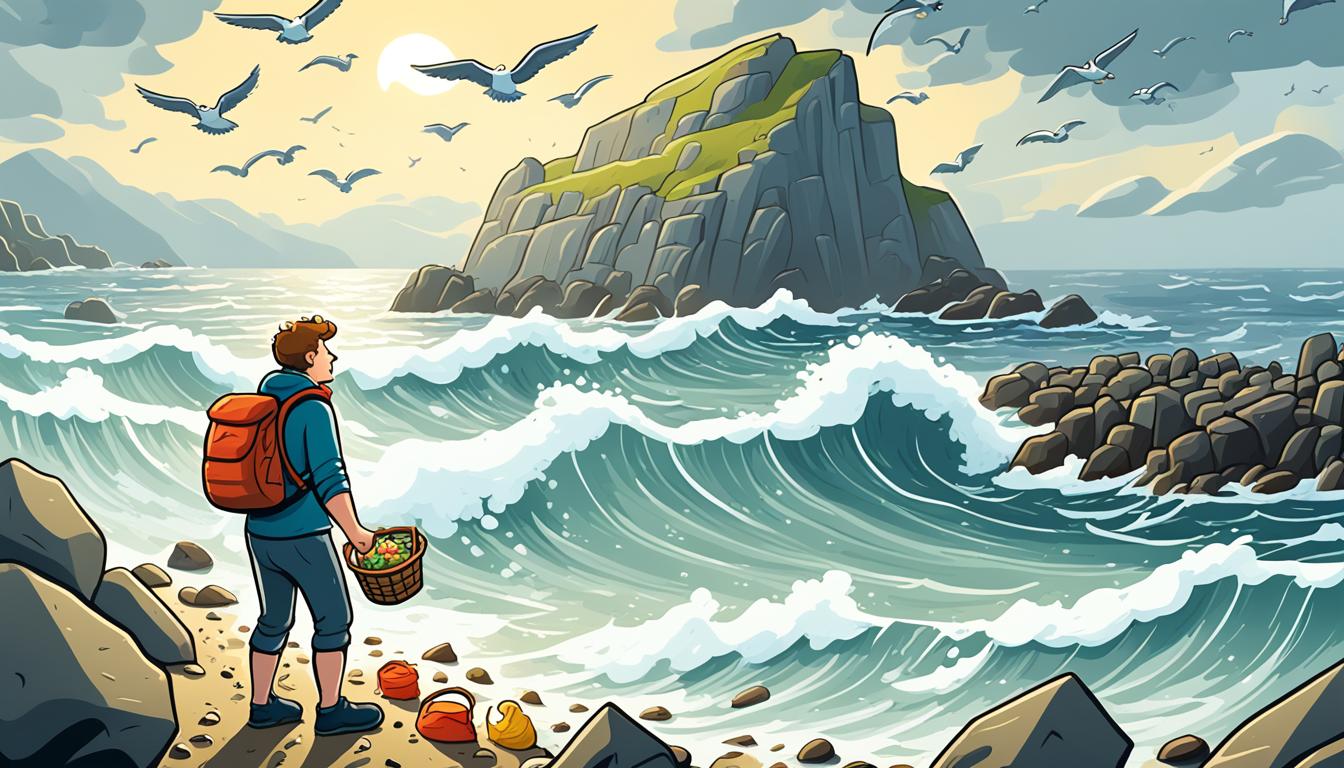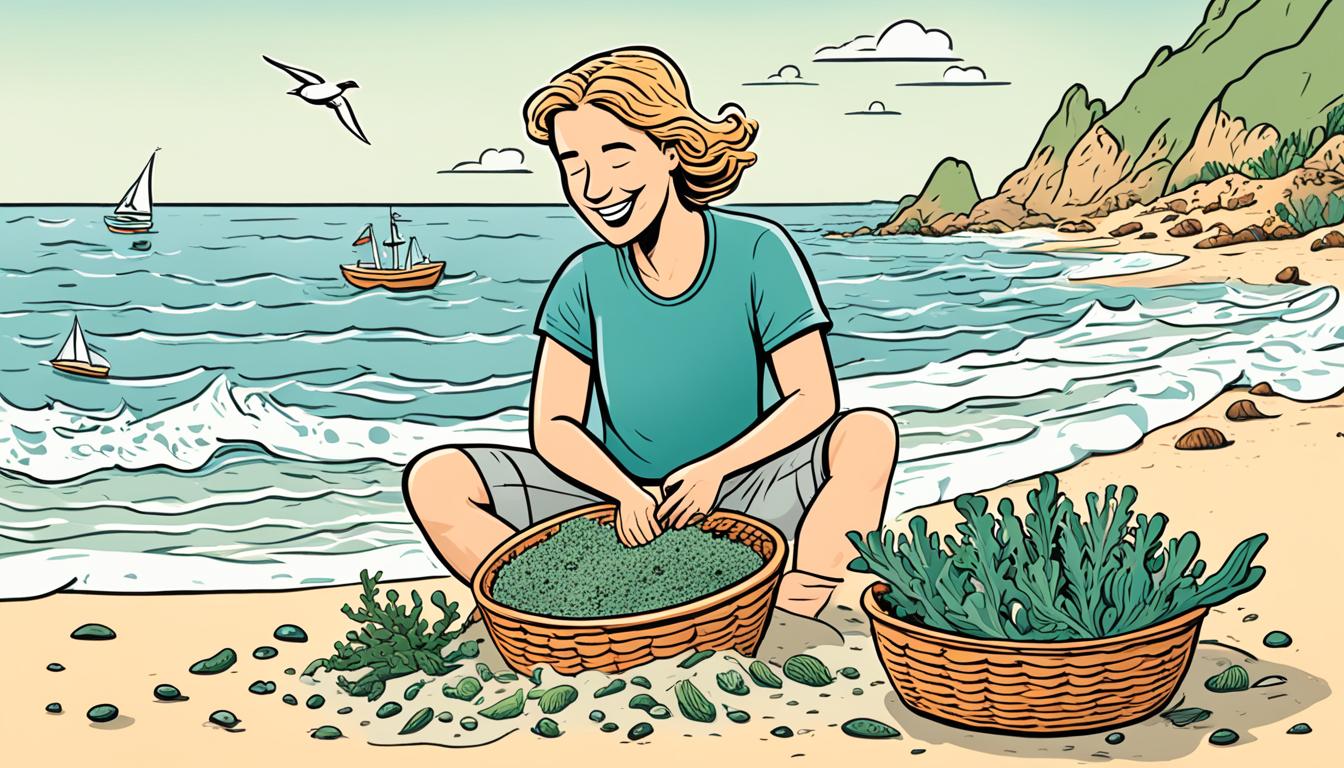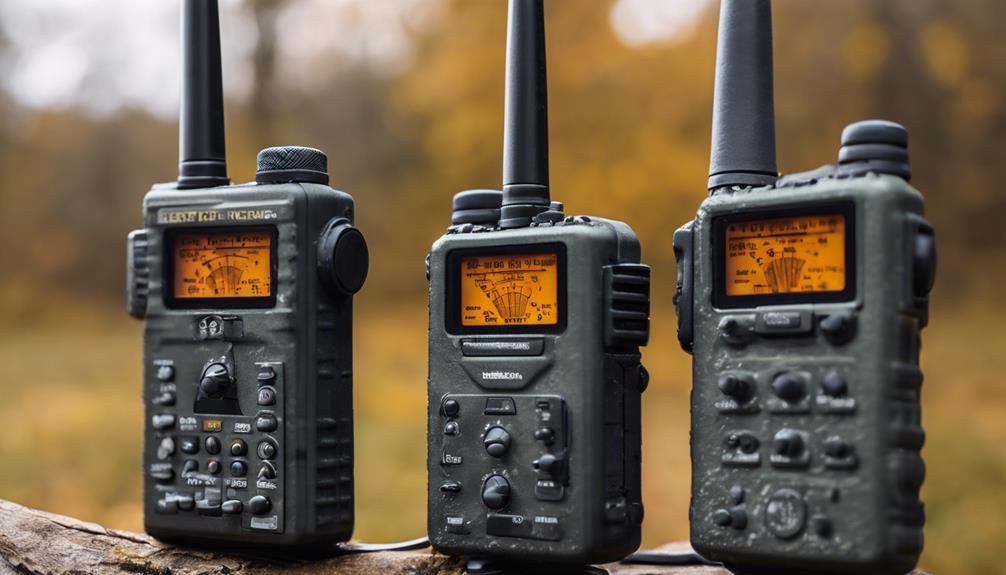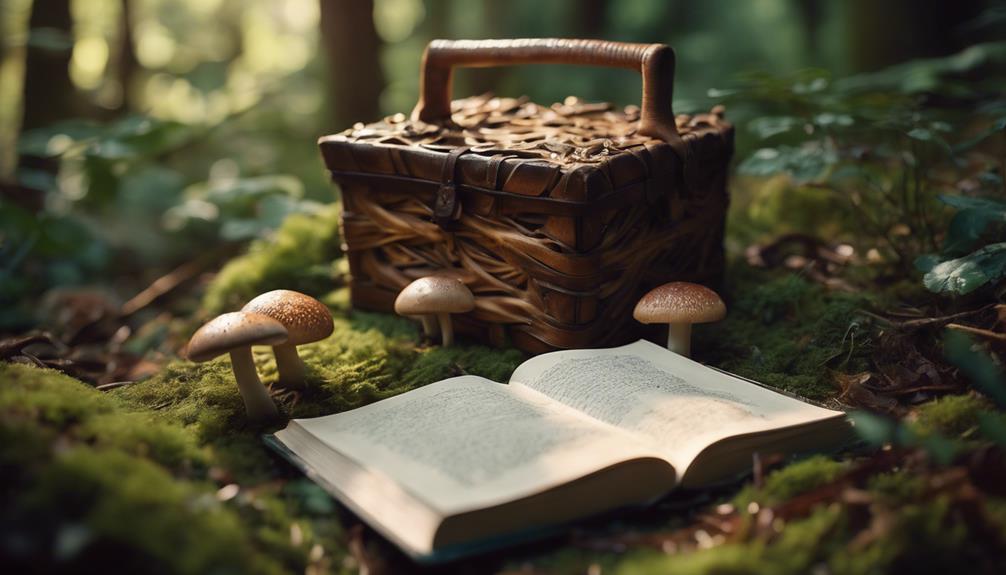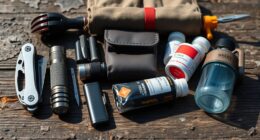Imagine strolling along the pristine shores of the Oregon Coast, surrounded by the rhythmic sound of crashing waves and the fresh, salty breeze. As you explore this picturesque landscape, you can’t help but be captivated by the untamed beauty and abundant natural resources that lie before you. The Oregon Coast offers a unique foraging experience, where you can embrace the thrill of discovering your own culinary treasures straight from nature’s pantry.
Coastal foraging in Oregon is a seasonal delight, with the peak season for foraging in Astoria and Warrenton spanning from the end of August after the first hard rain through the end of November after the first hard freeze. During this time, the coast comes alive with a vibrant array of wild plants, mushrooms, and shellfish, waiting to be harvested and savored.
Key Takeaways:
- Coastal foraging in Oregon is a seasonal adventure, with the peak season lasting from late August to late November.
- Home to a variety of wild plants, mushrooms, and shellfish, the Oregon Coast offers a bounty of delicious treasures.
- From beachcombing and edible seaweed foraging to tidepool exploration and wild food foraging, there are numerous foraging opportunities along the coast.
- Coastal plant identification is essential for ensuring the safe and responsible gathering of edible plants.
- By adhering to foraging regulations, practicing sustainable harvesting, and being aware of safety precautions, you can enjoy a fulfilling and respectful foraging experience.
Exploring Edible Plants on the Oregon Coast
When it comes to coastal foraging on the Oregon Coast, there is a bountiful array of edible plants just waiting to be discovered. From the salty samphire found in marshy areas to the vibrant miner’s lettuce thriving in shady spots, the variety is truly remarkable. These wild edibles not only provide a connection to the land but also offer a delicious and nutritious addition to your meals.
When venturing out to explore the edible plants of the Oregon Coast, it’s crucial to arm yourself with a good field guide for coastal plant identification. This will help you accurately identify the plants you come across to ensure their safety for consumption.
One noteworthy location for foraging miner’s lettuce is Jessie M. Honeyman Memorial State Park. This leafy green plant, identified by its small white flowers and tender leaves, is not only visually appealing but also a delightful addition to salads and other dishes. Its mild flavor and delicate texture make it a popular choice among foragers.
Remember to always practice sustainable foraging techniques and only harvest what you need, leaving behind enough for the plants and wildlife to thrive. By respecting nature’s offerings, we ensure that future generations can also enjoy the abundance of edible plants along the Oregon Coast.
Delving into Coastal Wild Foods
When it comes to coastal foraging along the Oregon coast, the opportunities for culinary exploration are boundless. The region is home to a diverse range of coastal wild foods, offering a bounty of flavors and nutritional benefits that can be harvested sustainably. One such category of wild foods is edible marine greens.

Exploring Edible Marine Greens
Edible marine greens, such as sea lettuce and sea rocket, are prized finds for coastal foragers. These greens can be found in the intertidal zones along the coast, with regions like Siletz Bay being known for their abundance. Sea lettuce and sea rocket not only offer a unique culinary experience but also contribute to a well-rounded and nutritious diet.
Sea lettuce, characterized by its vibrant green color and lettuce-like appearance, adds a fresh and mild flavor to dishes. Rich in vitamins and minerals, it is a versatile green that can be enjoyed in salads, wraps, or as a garnish. Sea rocket, on the other hand, brings a peppery taste reminiscent of arugula to the table. Its zesty flavor can elevate everything from sandwiches to pasta dishes.
Foraging for these marine greens along the Oregon coast allows you to connect with nature and experience the thrill of sourcing your food directly from the ocean’s edge. With their unique flavors and nutritional profiles, sea lettuce and sea rocket open up a world of culinary possibilities.
Preserving the Coastal Ecosystem
While foraging for coastal wild foods is a rewarding activity, it is important to approach it with the utmost respect for the environment. Foragers are encouraged to practice sustainable foraging techniques to ensure the preservation of the ecosystem. This includes cutting seaweeds instead of uprooting them and only taking what can be consumed, allowing for continued growth and regeneration.
Discovering Prime Foraging Spots
Along the Oregon coast, there are specific areas that are considered prime locations for foraging. Places like Jessie M. Honeyman Memorial State Park and Cape Blanco are renowned for their diverse coastal ecosystems, making them popular among foragers. These areas offer an abundance of wild foods, including edible marine greens.
To fully explore the coastal ecosystem and discover the treasures it holds, it is recommended to join foraging workshops or seek guidance from local experts. Coastal town Newport, in particular, stands as a hub for foraging workshops, showcasing the significance of these locations for those interested in coastal foraging.
Shellfish License Fees
| Residency Status | License Fee |
|---|---|
| Resident | $7 |
| Out-of-State Individual | $20.50 |
| Three-Day Nonresident | $11.50 |
Foraging along the Oregon coast offers a unique opportunity to connect with nature and explore the abundance of coastal wild foods. From the thrill of discovering edible marine greens like sea lettuce and sea rocket to the responsibility of practicing sustainable foraging techniques, this coastal foraging journey is both enriching and delicious.
Harvesting Seaweed from the Oregon Coast
Seaweed harvesting is a popular and rewarding activity along the breathtaking Oregon Coast. With its diverse marine ecosystem, the coast offers a wide variety of seaweeds that can be harvested sustainably. From kelps like Kombu and Nori to the vibrant Green Laver and nutrient-rich Bladderwrack, there are numerous types of seaweed waiting to be discovered and enjoyed.
The live seaweed harvesting season in Oregon spans from March 1st to June 15th, providing ample opportunities to gather these edible and nutritious marine plants. However, it’s important to adhere to the regulations and guidelines set in place to ensure the preservation of these valuable resources. Harvesters are limited to one-gallon volume container per day and up to three gallons per calendar year, preventing overharvesting and allowing for continued growth.

When harvesting seaweed, it’s crucial to do so by hand using a knife or similar instrument, as the use of rakes or forks is prohibited. This method ensures that the seaweed is carefully and sustainably harvested, minimizing any damage to the surrounding environment. Furthermore, certain species such as Sea Palm, eel grass, and surf grass are off-limits for harvesting to protect their delicate ecosystems.
The Oregon Coast is home to over 50 different species of wild seaweed, each with its own unique characteristics and flavors. Some highly recommended types of seaweed for harvesting in Oregon include Wakame, Kombu, Green Laver, Bladderwrack, Nori, and Dulce. These seaweeds not only add depth and umami to your dishes but are also packed with essential nutrients and minerals.
| Key Information about Seaweed Harvesting in Oregon |
|---|
| The live seaweed harvesting season runs from March 1st to June 15th |
| Harvesters are limited to one gallon per day and three gallons per year |
| Harvesting by hand using a knife or similar instrument is allowed |
| Using rakes or forks for harvesting is prohibited |
| Some species such as Sea Palm, eel grass, and surf grass are off-limits |
| Harvesting of non-living seaweeds is allowed except in snowy plover management areas during seasonal closures |
One of the prime locations for seaweed harvesting on the Oregon Coast is Cape Blanco. It offers a rich abundance of kelps, dulse, and nori. When harvesting seaweed, it’s important to ensure that the seaweed appears fresh, without signs of deterioration or a strong odor. This guarantees that you’re collecting high-quality seaweed that will enhance the flavors of your culinary creations.
May and June, in particular, are the most productive months for seaweed harvesting on the Oregon Coast. The favorable weather conditions and nutrient-rich waters create an ideal environment for seaweed growth and development. It’s an opportune time to explore the coast and gather an array of seaweeds to savor and share with friends and family.
Tips for Sustainable Seaweed Foraging
- Avoid clearing areas of seaweed and allow for continued growth throughout the year.
- Practice cutting seaweed rather than uprooting to ensure its sustained growth.
- Proper seaweed identification is essential for safe and responsible harvesting.
- Take only what you need, respecting the balance of nature’s ecosystem.
- Follow daily and yearly limits to prevent over-harvesting and enable healthy regrowth.
Drying harvested seaweed is a convenient way to prepare it for consumption, as fresh seaweed doesn’t easily fit into a Westerner’s diet. It can be rehydrated in soups or pasta dishes, extracting its mineral-rich goodness into the food. Dried seaweed can also be crushed and used as a seasoning or ingredient, adding nutritional benefits to a variety of dishes.
If you plan to transport harvested seaweed for more than six hours, it’s recommended to keep it chilled or on ice to maintain its freshness and prevent breakdown. Additionally, dried seaweed can be transformed into healthy snacks resembling chips, offering a nutritious alternative to traditional snacks. Introducing seaweed chips to children early on can foster healthier eating habits and expand their culinary horizons.
Seaweed is renowned for its numerous nutritional benefits, making it a valuable addition to any diet. It is a rich source of omega-3, naturally occurring vitamins, and essential trace elements that promote a healthy body and mind. Incorporating seaweed into your meals not only adds a unique flavor but also provides a nutrient boost that supports overall well-being.
Exploring the World of Wild Mushrooms
When it comes to coastal foraging in Oregon, the lush rainforests of the Tillamook State Forest are a true haven for mushroom enthusiasts. This diverse ecosystem is home to a variety of wild mushrooms, including the highly sought-after chanterelles and fly agaric mushrooms. However, foragers must exercise caution as many edible mushrooms have toxic look-alikes that can be easily mistaken.
If you’re new to wild mushroom picking or want to enhance your knowledge, joining mushroom hunting workshops is highly recommended. These workshops, available in coastal towns like Newport, provide valuable guidance from expert guides who can assist in identifying edibles and ensuring a safe and successful foraging experience.
From delectable culinary delights to fascinating and unique fungi, the world of wild mushrooms on the Oregon coast awaits exploration. Make sure to equip yourself with the necessary knowledge and skills to fully enjoy the wonders that the coastal forests have to offer.

Identification Class at Fort Stevens State Park
“The identification class for mushrooms held at Fort Stevens State Park in Astoria showcases the enthusiasm and interest in learning about and exploring the vast array of wild mushrooms that thrive in the coastal forests of Oregon.”
From Edible to Exquisite: Mushrooms of the Coastal Forests
Explorers who have ventured into the coastal forests have discovered a wide range of mushrooms. While some species are edible but not particularly flavorful, others, such as the highly prized king bolete (porcini), are considered choice edibles with exquisite taste.
To truly appreciate the culinary delight of wild mushrooms, various recipes are shared among foragers. These recipes highlight the versatility and culinary appreciation of these natural treasures. From sautéed delicacies to mouthwatering mushroom risottos, the possibilities are endless when it comes to incorporating wild mushrooms into your meals.
Bountiful Mushrooms at Nehalem Bay State Park
Nehalem Bay State Park stands out as a hot spot for mushroom enthusiasts, particularly the king boletes. This forested area is known for hosting a significant number of these prized mushrooms, suggesting a concentrated growth in the region. Foragers can expect a bountiful harvest during the fall season, making Nehalem Bay State Park a must-visit destination for mushroom hunters.
Abundance in Nehalem: A Bumper Crop of Boletes
Compared to other locations visited during explorations, Nehalem Bay State Park boasts a bumper crop of boletes. This indicates a more abundant occurrence of these mushrooms in the area, providing ample opportunities for foragers to gather and enjoy their harvest.
| Location | Abundance of King Boletes |
|---|---|
| Nehalem Bay State Park | Bumper crop |
| Other Locations | Varying levels |
Seasonal Availability: Insights into Wild Mushroom Growth
The statistical information within this article focuses on the seasonal availability of wild mushrooms in specific regions along the Oregon coast. These insights provide a deeper understanding of the environmental conditions that promote mushroom growth in these areas. By aligning your foraging pursuits with nature’s rhythm and bounty, you can enhance your chances of finding a diverse array of wild mushrooms.
Indulging in Native Berries of the Pacific Northwest
When it comes to coastal foraging along the Oregon Coast, the Pacific Northwest’s native berries are a true delight. As you explore the coastal trails, including the beautiful Samuel H. Boardman State Scenic Corridor, you will encounter a variety of delicious berries just waiting to be picked.
Salal berries, thimbleberries, and evergreen huckleberries are among the popular native berries that thrive along Oregon’s coastal public lands. The season for these berries varies, with salmonberries and red huckleberries peaking by mid-July, while evergreen huckleberries, salal berries, and blackberries often persist into September. Plan your coastal foraging adventure accordingly to enjoy a bountiful harvest.
Native Berries of the Oregon Coast
| Types of Native Berries | Description |
|---|---|
| Red and Black Evergreen Huckleberries | These berries offer a sweet and tangy flavor, perfect for jams, pies, or simply enjoying fresh. |
| Night-Blue Salal Berries | Salal berries are known for their deep blue color and make a delicious addition to salads or desserts. |
| Crimson Thimbleberries | Thimbleberries are delicate and juicy, often used in preserves or enjoyed straight from the bush. |
| Sunset-Colored Salmonberries | Salmonberries provide a burst of sweet and tart flavors, perfect for snacking or adding to baked goods. |
| Amaranthine Blackberries | Blackberries are a Pacific Northwest staple, bursting with flavor and ideal for a variety of culinary creations. |
Remember, when foraging for native berries, it’s important to only pick what you can consume and leave some for wildlife and others to enjoy. The natural beauty of the Pacific Northwest is meant to be shared, and responsible foraging ensures the sustainability of these berries for years to come.
So, grab your foraging basket, head out to the scenic coastal trails, and indulge in the native berries of the Pacific Northwest. There’s something truly special about savoring the flavors of the Oregon Coast straight from nature’s pantry.

Learning from Foraging Experts and Workshops
If you’re new to foraging and looking to enhance your coastal foraging skills, learning from experts and joining workshops is a fantastic opportunity. Along the picturesque Oregon coast, you’ll find numerous workshops and guides available to help you navigate the world of foraging.
One of the coastal towns that stands out as a hub for foraging workshops is Newport. This charming town is home to knowledgeable locals who have generations of experience in identifying edible plants and exploring the coast’s bounties. By learning from these experts, you can gain valuable insights into the best spots for foraging and the sustainable practices necessary to preserve the ecosystem.
These workshops provide an immersive experience where you can walk alongside seasoned foragers and learn from their extensive knowledge. They offer hands-on training, interactive sessions, and detailed explanations of coastal plant identification, mushroom hunting, and even seaweed harvesting. With their guidance, you’ll become familiar with the local flora and fauna, ensuring a safe and rewarding foraging adventure.
Why Learn from Locals?
When it comes to foraging, there’s no substitute for learning from locals. They possess a deep understanding of the specific coastal areas, knowing the best seasons, locations, and techniques for successful foraging. Their expertise is invaluable, as they provide insider tips and impart wisdom that can only be gained through years of firsthand experience.
“Learning from locals allows you to tap into a wealth of knowledge passed down through the generations. Their insights and expertise will greatly enhance your foraging experience, ensuring you gather the most flavorful and abundant harvests along the Oregon coast.” – Local Foraging Expert
By learning from these experts, you’ll not only expand your foraging skills but also develop a deeper connection to the coastal environment. They can introduce you to the delicate balance between sustainable foraging and conservation, teaching you to identify edible species while preserving the natural habitat.
Whether it’s the secrets of finding elusive chanterelles and fly agaric mushrooms in the Tillamook State Forest or discovering the best coastal towns and seasons for foraging workshops, the insights you gain from local experts will elevate your foraging adventures.

| Workshop Highlights | Location | Date |
|---|---|---|
| Coastal Plant Identification | Newport | August 15, 2022 |
| Mushroom Hunting Workshop | Tillamook State Forest | September 10, 2022 |
| Seaweed Harvesting and Cooking | Depoe Bay | October 2, 2022 |
Tidal Zone Foraging: Clamming on the Oregon Coast
When it comes to coastal foraging in Oregon, clamming on the Oregon Coast is an activity that shouldn’t be missed. The tidal zones along the coast provide abundant opportunities to search for razor clams and butter clams, which are highly sought-after delicacies. Whether you’re an experienced clammer or a beginner, this exhilarating activity offers a unique way to connect with nature and indulge in the coastal bounty.
Before embarking on your clamming adventure, it’s important to familiarize yourself with the local clamming regulations. In Oregon, razor clam beaches in Clatsop County and nearby areas are closed from July 15 to September 30 to protect the clam populations during their reproductive season. Additionally, everyone 12 years or older will need a shellfish license to clam or crab in Oregon, ensuring sustainable harvesting practices and conservation efforts.
It’s crucial to adhere to the regulations set in place, as they not only protect the health of the clam populations but also ensure the safety of those consuming the clams. The regulations include legal harvest methods and specify the number of clams of each species that can be kept. For example, razor clam harvest limits are set at 15 per day, while purple varnish clams allow for a harvest of up to 72 clams per day.
When planning your clamming excursion, consider exploring Siletz Bay, a rich intertidal zone known for its abundant clam populations. This scenic location offers a picturesque setting for your clamming adventure and the opportunity to gather a bountiful harvest.
As you venture along the coast, you’ll also discover other foraging gems. Jessie M. Honeyman Memorial State Park is a noteworthy location with abundant miner’s lettuce, a delightful edible plant rich in nutrients and flavor. Cape Blanco is another standout spot, renowned for its diverse seaweed offerings, including kelps, dulse, and nori.
While the ocean offers an incredible bounty, it’s important to forage responsibly and sustainably. The Tillamook State Forest, with its lush coastal rainforests, is a mycologist’s paradise, providing ample opportunities for wild mushroom picking. However, it’s essential to take precautions and properly identify mushrooms before consumption, as some species can be toxic.
The Samuel H. Boardman State Scenic Corridor is another area to explore, as it is home to native berries such as salal berries and thimbleberries. These delicious berries add a burst of flavor to your foraged meals and offer a taste of the Pacific Northwest.
If you’re new to coastal foraging or want to enhance your knowledge, consider visiting Newport, a coastal town that serves as a hub for foraging workshops. These workshops provide valuable insights from local experts who have generations of knowledge about the best spots to forage and how to do so sustainably.
Before heading out for clamming or any other foraging activity, make sure to obtain the necessary permits and licenses. It’s also important to stay informed about red tide warnings, which indicate the presence of harmful algal blooms that can make shellfish unsafe for consumption.
In Oregon, bag limits on clams and protected foraging areas are part of the safety regulations in place to ensure the preservation of these natural resources. This helps maintain a healthy balance between harvesting and conservation, ensuring the sustainability of the ecosystem.
It’s worth noting that some species, like Gooseneck Barnacles, are susceptible to large-scale commercial harvesting, putting them at risk of extinction. By practicing responsible foraging and respecting the regulations, we can contribute to the preservation of these cherished species.
Seize the opportunity to explore the tidal zones and engage in the exhilarating activity of clamming on the Oregon Coast. The rewards of a successful clamming adventure, paired with the breathtaking coastal scenery, make it an experience you won’t soon forget.

Clamming Regulations
| Clam Species | Harvest Limits |
|---|---|
| Razor clams | 15 per day |
| Butter clams | Varies (check local regulations) |
| Purple varnish clams | 72 per day |
Foraging Safety and Regulations in Oregon
When embarking on a coastal foraging adventure in Oregon, it’s crucial to prioritize safety and adhere to the regulations in place. By doing so, you can ensure a responsible and sustainable foraging experience that preserves the natural resources for future generations.
Here are some essential foraging safety tips to keep in mind:
- Know your limits: Before you start foraging, familiarize yourself with the specific regulations and bag limits for different types of foraged foods. For example, when clamming for razor clams and butter clams, be aware of the daily and yearly harvest limits.
- Respect protected areas: Some areas along the Oregon Coast have restrictions or are completely off-limits for foraging. It’s crucial to respect these areas to preserve delicate ecosystems and protect vulnerable species.
- Identify edible species: Invest in a reliable field guide or join foraging workshops to properly identify edible plants, seaweeds, and mushrooms. Remember, accurate identification is essential to avoid consuming potentially harmful or protected species.
- Practice sustainable foraging: Adopt sustainable foraging practices, such as not overharvesting, cutting rather than uprooting plants, and leaving enough for wildlife and natural regeneration. This ensures the long-term health of the coastal ecosystems and their respective edible species.
- Be prepared: Before heading out, equip yourself with the necessary tools, such as appropriate containers for gathering and sturdy footwear for navigating varied coastal terrains. Additionally, check weather conditions and tides to plan your foraging trip safely.
It’s also vital to stay updated on current regulations and any changes that may occur. Check the official websites of local agencies and organizations dedicated to the preservation of Oregon’s natural resources for the latest information.
By following these safety tips and regulations, you can have an enjoyable and responsible foraging experience along the beautiful Oregon Coast.
Conservation Efforts and Protecting Vulnerable Species
“Certain species, such as Gooseneck Barnacles, are vulnerable to overharvesting, with only about 2 percent of the population large enough to be harvested. It highlights the importance of sustainable practices and conservation efforts.”
Sustainable foraging practices play a significant role in protecting the natural resources along the Oregon Coast. By foraging responsibly, you help preserve the delicate balance of ecosystems and contribute to the conservation of vulnerable species.
One way to contribute to conservation efforts is by being mindful of the species that are completely off-limits for harvesting. For example, Sea Palm, eelgrass, and surf grass are protected species and should not be gathered. Respect these regulations to support the recovery and preservation of these important coastal plants.
Seaweed Harvesting Regulations on the Oregon Coast
| HARVESTING SEASON | LIMITS | EXCEPTIONS | PRODUCTIVE MONTHS |
|---|---|---|---|
| Live seaweed harvesting | March 1st to June 15th | One-gallon volume container per day Up to three gallons per calendar year |
May and June |
| Salvaging non-living seaweeds | All year round (except in snowy plover management areas) | N/A | N/A |
During the live seaweed harvesting season, which spans from March 1st to June 15th, there are specific limits in place to ensure the sustainable gathering of these marine plants. Harvesters are allowed to collect up to one gallon volume per day and a maximum of three gallons per calendar year. It’s important to abide by these limits to prevent overharvesting and support the continued growth and regeneration of seaweeds along the coast.
May and June are considered the most productive months for seaweed harvesting on the Oregon Coast. During this time, the sunny conditions are ideal for annual seaweeds to commence their growth cycle, providing abundant opportunities for foraging enthusiasts.
Remember, sustainable foraging practices are essential to protect these valuable coastal resources. By respecting regulations and adopting responsible harvesting techniques, you contribute to the preservation of Oregon’s natural beauty and ensure the availability of wild foods for generations to come.

Conclusion
Coastal foraging on the Oregon Coast offers a unique and fulfilling experience, allowing you to connect with nature and discover the bounty it has to offer. By following the coastal foraging tips and guidance provided in this guide, you can enjoy the seasonal harvests and practice sustainable foraging practices for a more enriching and responsible foraging experience.
Remember to always be aware of safety precautions and regulations while engaging in coastal foraging in Oregon. This ensures a safe and enjoyable foraging adventure. Whether you are exploring edible plants, delving into coastal wild foods, harvesting seaweed, or embarking on a wild mushroom hunt, sustainable foraging practices are essential to conserve and protect the coastal ecosystem.
Coastal foraging in Oregon is an opportunity to embrace the natural abundance and diversity of the coast, while respecting and preserving it for future generations. So grab your knife, basket, and field guide, and embark on an adventure to connect with the Oregon Coast in a delicious and sustainable way.
FAQ
What is coastal foraging?
What can I find while beachcombing in Oregon?
Are all seaweeds edible?
Can I forage in tidepools along the Oregon coast?
How can I identify edible mushrooms while foraging?
Are there any poisonous berries on the Oregon coast?
What can I learn from foraging workshops on the Oregon coast?
Do I need a permit for clamming on the Oregon coast?
How can I forage responsibly and sustainably on the Oregon coast?
What are some general tips for coastal foraging in Oregon?
Source Links
- https://www.travelastoria.com/trip-ideas/wild-harvest–a-guide-to-foraging-and-clamming.html
- https://visittheoregoncoast.com/travel-guides/how-to/guide-to-wild-mushrooms-on-the-oregon-coast/
- https://www.altpdx.com/beginners-guide-to-mushroom-foraging-in-oregon/
- https://www.kiwandacoastalproperties.com/blog/foraging-on-the-oregon-coast/
- https://www.moon.com/travel/food-drink/foraging-oregons-coast/
- https://1859oregonmagazine.com/explore-oregon/outdoors/coastal-foraging-adventures-oregon/
- https://mwg.aaa.com/via/things-do/foraging-oregon-coast
- https://www.shiftingtidesnw.com/blog/seaweed-foraging-on-the-oregon-coast
- https://www.theperfectnutrition.com/harvesting-seaweed-on-the-oregon-coast/
- https://ravenandchickadee.com/2019/02/mushroom-hunting-on-the-oregon-coast/
- https://www.seattlemet.com/travel-and-outdoors/2022/05/northwest-berries-seattle-fruit-farms-berry-picking
- https://www.seasideor.com/seaside-stories/mushroom-foraging-near-seaside/
- https://myodfw.com/articles/start-clamming
- https://blogs.oregonstate.edu/gemmlab/tag/foraging-ecology/
- https://discover.texasrealfood.com/mushroom-hunting-by-state/oregon

